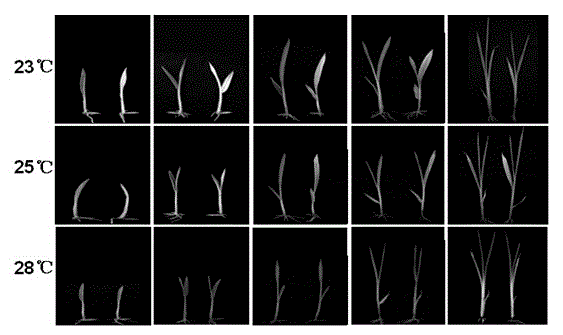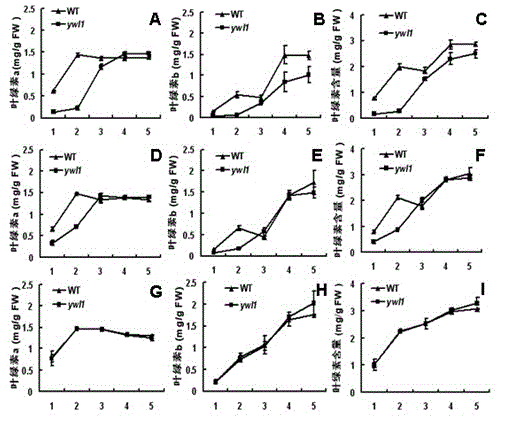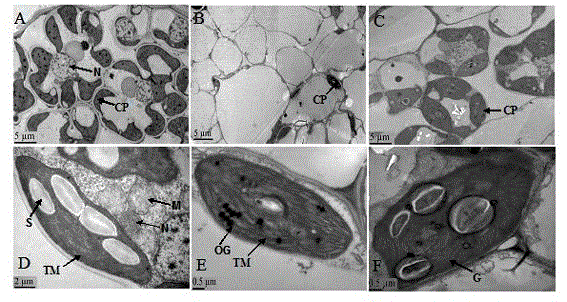Gene YWL1 for controlling rice leaf color at low temperature and application of gene YWL1
A technology of leaf color and gene, applied in application, genetic engineering, plant genetic improvement, etc., can solve the problem of unclear nuclear-cytoplasmic interaction mechanism
- Summary
- Abstract
- Description
- Claims
- Application Information
AI Technical Summary
Problems solved by technology
Method used
Image
Examples
Embodiment 1
[0038] Example 1: YWL1 map-based cloning
[0039] a) Rice material
[0040] Rice (Oryza sativa L) mutant ywl1 , the original wild-type material was indica rice variety 93-11.
[0041] b) Determination of chlorophyll content and photosynthetic characteristics
[0042] Soak the plump mutant and wild-type seeds to accelerate germination, sow the germinated mutant and 93-11 seeds in a pot, and place them in an artificial climate box at 23°C, 25°C, and 28°C, with 12 hours of light and 12 hours of dark treatment. cultivated in. Observe and record mutant phenotypes. The chlorophyll content of the leaves was measured at the first, second, third, fourth and fifth leaf stages.
[0043] Determination of chlorophyll content: Soak 0.1g-0.2g of the sample to be tested in 10ml of 95% ethanol, and place it in a refrigerator at 4°C to extract the pigment for about 48 hours. Measure the OD value under 665nm, 649nm, 470nm wave light with a type spectrophotometer. The contents of chl...
Embodiment 2
[0068] Embodiment 2: transgenic experiment
[0069] Plant Transformation:
[0070] 1. Vector Construction
[0071] Design a pair to completely cover the entire YWL1 Gene ORF primers, and 15 bases on both sides of the vector pCUbi1390 restriction site BamHI were added to the primers, the wild-type genomic DNA was amplified by PCR, and electrophoresis was used to detect and recover by gel cutting. The recombinant kit (Clontech, In-Fusion HD Enzyme) was connected to the pCUbi1390 vector linearized by BamHI digestion of the stem, and after being confirmed by sequencing, it was transformed into Agrobacterium ( A grobacterium tumefaciens ) in the EHA105 strain.
[0072] The primer sequence for amplifying the ORF sequence is:
[0073] RGg5F:GCAGGTCGAC GGATCC TATCCGATAACCGATAAAC (SEQ ID NO. 27)
[0074] RGg5R: GAATTCCCGG GGATCC CATAAGCAGGTTTGAGAAG (SEQ ID NO. 28)
[0075] 2. Genetic transformation:
[0076] (1) Selection of transformed receptors
[0077] will mutant y...
Embodiment 3
[0080] Example 3: YWL1 Chloroplast positioning experiment of (SEQ ID NO.2)
[0081] according to YWL1 The CDS sequence (SEQ ID NO.2) designed primers containing XholI and SalI restriction sites, and its sequence is:
[0082] PGXhF: TTT ctcgag ATAAACCCCTCCCCCACTCTCCAC (SEQ ID NO. 29)
[0083] PGSalR: TTT gtcgag CCAAATTTGATATTGCACAATGGGA (SEQ ID NO. 30)
[0084] Using wild-type cDNA as a template, amplified with high-fidelity enzymes YWL1 The CDS sequence of the gene (removing the stop codon), the amplified product was sequenced and verified to be correct, and then ligated with the PAN580-GFP vector to obtain the fusion expression vector 35S::YWL1:GFP.
[0085] Extract and construct the fusion expression vector 35S::YWL1:GFP plasmid and 35S::GFP without gene fusion to transform rice protoplast cells by PEG-mediated method. The rice protoplast cells after bombardment were cultured in the hypertonic medium for 16 hours in the dark, and then observed under a fluor...
PUM
 Login to View More
Login to View More Abstract
Description
Claims
Application Information
 Login to View More
Login to View More - R&D
- Intellectual Property
- Life Sciences
- Materials
- Tech Scout
- Unparalleled Data Quality
- Higher Quality Content
- 60% Fewer Hallucinations
Browse by: Latest US Patents, China's latest patents, Technical Efficacy Thesaurus, Application Domain, Technology Topic, Popular Technical Reports.
© 2025 PatSnap. All rights reserved.Legal|Privacy policy|Modern Slavery Act Transparency Statement|Sitemap|About US| Contact US: help@patsnap.com



